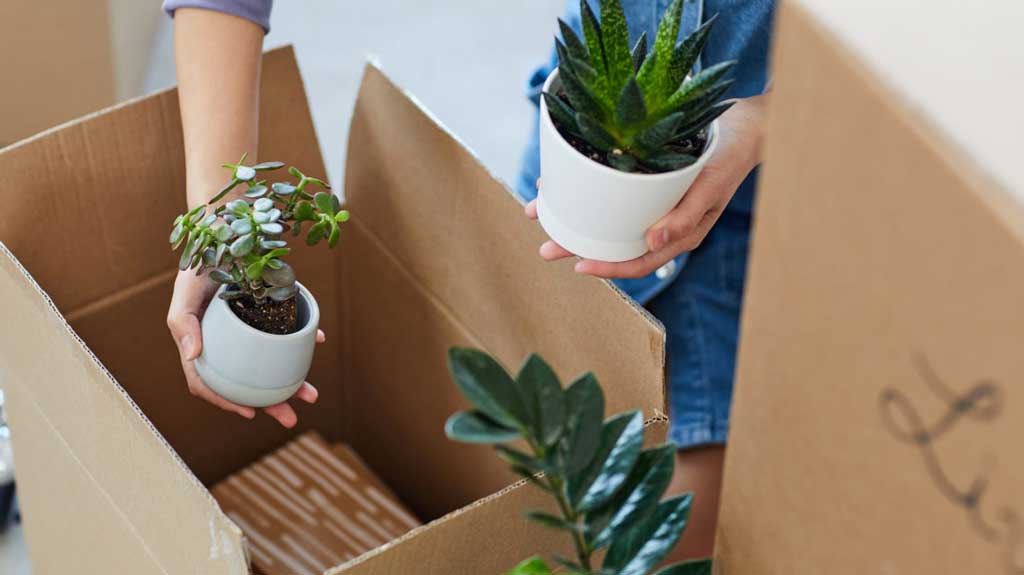If you’re a plant owner and moving to a different state, you might want to take your plants with you. After all, you’ve put a lot of love and care into them. But do you know how to move plants across the country legally and safely? We have some suggestions to help you figure it out.
1. Research regulations in your new state.
First, find out if the state you’re moving to and the states you’ll be traveling through to get there allow your type of plants. Insects and the diseases they bring can wreck a state’s ecosystem. That’s why some states, such as California, Oregon, Washington, Arizona, or Florida, have strict rules about what they’ll allow. Make sure to check for both indoor and outdoor varieties.
Check with the U.S. Department of Agriculture or the specific state’s department of natural resources. Either will provide you with guidelines and regulations.
2. Can they thrive in your new home?
Determine the best kind of environment for your plants to grow and thrive. Some do well no matter where they’re planted, while others need specific weather patterns to survive. Find out ahead of time what your plants need and whether or not your new climate can provide it.
3. Choose the best way to transport them.
How are you getting to your new home? Most people hire moving companies and then either fly or drive themselves separately. Consider your situation and what might work best for you and your plants. Here are some ideas:
Car
- This is the easiest option because they’ll be with you the entire time.
- You’ll avoid lengthy packing and shipping issues.
- You can water and care for them as needed.
- A great choice for how to move plants, as long as you have enough room in your car.
Airplane
- Follow all TSA rules.
- Check them as baggage and follow all packing requirements.
- Plants can be carry-on items as long as they conform to size limits.
Parcel Service
- USPS, UPS, and FedEx ship plants.
- Check the shipping service guidelines.
- Choose the fastest shipping method.
- Avoid weekends and holidays.

4. Check for pests.
Does your new state require a certified inspection? If so, call the agriculture department office near your home. They will give you examination information and paperwork.
5. Water your plants.
Do this 2-3 days before the move. You want the soil moist but not soaking wet. Most plants can survive without water for 7-10 days. Keep the roots damp during this time by watering them before packing.
6. Pack them properly.
Now that you’ve chosen the method by which your plants will get to their new home, here’s how to pack them so they arrive safely.
Flying
Follow the regulations for whichever airline you’re using.
Shipping
Each shipping company provides packing instructions. You can also check with a local nursery for guidance.
Driving
Secure your plants so that each one gets enough air. Here are some effective ways to do that:
Potted plants
- Move the plant into a plastic container with new soil a few weeks before your move.
- Pack the original clay or ceramic pots like any other fragile item.
- Cover the bottom of the plastic container with a plastic bag.
- Tie or tape it at the base so the soil doesn’t spill.
- Secure the plant inside a box strong or taped enough to hold it.
- Fill any extra space around the pot with packing paper or newspaper.
- Poke air holes in the sides of the box.
- Label it FRAGILE and keep it upright in your car.
Cuttings
- If your plants are too big to move, take a stem or root piece from it. You can replant this cutting at your new place.
- Cut a 3- to 6-inch-long area of the plant with healthy growth using a clean cutter.
- Do this the morning of your move.
- Wrap it in wet paper towels secured with rubber bands to keep it moist.
- Place a plastic stem holder over the stem or use a small plastic bag.
- Use gentle care.
A new place will feel more like a home with familiar items you love. This includes plants. If you have more questions about how to move plants, call Colonial Van Lines and talk to the experts.

